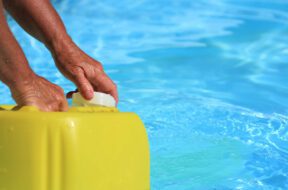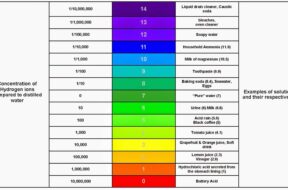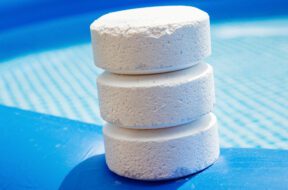
Want to learn more about algaecide? Read on to find out when to add algaecide to your pool maintenance routine and other helpful tips.
The Calcium Saturation Index (CSI) is a helpful tool for testing your swimming pool’s health. This tool uses a variety of measurements to gauge this health, and is actually quite simple in practice. On Pool Calculator we’ll be diving into the CSI. This includes talking about what the CSI is, the effect of a CSI number that is too high or low, and how you can revert this number back to a “normal” level.
Click here for more information on calcium hardness!
The Calcium Saturation Index, or CSI, is a method of determining whether your water will deposit calcium carbonate or maintain it in the solution. You want your water to maintain its calcium in the water. Depositing the calcium causes the problems. This index is important because it incorporates all five of the balance factors into its number; pH, total alkalinity, calcium hardness, temperature, and total dissolved solids.
The index, in short, determines whether your water is normal, corrosive, or scale forming. A perfect number on the CSI scale is 0, meaning that the water is neither corrosive nor scale forming. “Normal” numbers for the CSI scale are between -0.3 and +0.3 on the scale. Anything below these numbers are considered corrosive. Anything above these numbers are considered scaling. Having a number on the scale that is either too high or too low can be harmful and damage the pool surface. It can also hurt the equipment you use, and area surrounding the pool.
Corrosive water is harmful to all surfaces it comes in contact with. Water with a CSI level under -0.4 is considered corrosive. This water is harmful because it will slowly dissolve materials it comes in contact with. Deterioration of these materials can cost the pool owner a hefty sum in property damages. There is a surefire way to treat this corrosion. The solution is to treat the water with water softeners and aeration systems (bases). These treatments will raise the pH of your water. These softeners work by removing the calcium and magnesium from the water. They then will inject sodium and potassium back into the water. The end goal of this process is a reduced “water hardness” that will bring your water back to normal levels on the CSI scale.
Click here to learn more about alkalinity, and corrosion.
While scaled water is not nearly as harmful to surfaces as corrosive water, scaling water still causes headaches. Water with levels over +0.4 will eventually create mineral deposits. The deposits can build up in your pool on the surfaces and are a pain to treat and remove. They form because of dissolved compounds of calcium and magnesium from the water. Compounds form a hard solid on surfaces. These compounds are a side effect of water that is too high on the CSI scale. To treat scaling water, you will need to add acids into your pool to bring the pH down, thus lowering the overall CSI number. The actual mineral deposits can be treated with high temperatures and vinegar but are difficult to remove and may leave chemical damage behind.
Testing your pool’s Calcium SI is very quick and simple. Like previously stated, the CSI is pulled from five factors; pH, total alkalinity, calcium hardness, temperature, and total dissolved solids. These can all be determined with a thermometer and a testing strip. Once all have been found by you, the rest is on us. Using our Pool Calculator App (click here) you can reach the goal CSI in your pool water. Our handy tool will use your pool dimensions and measurements along with your test values to determine what chemical treatment is necessary to be performed on your water. The end result will be a pool that is perfectly balanced and ready for extensive use!
Click here to use our easy Pool Calculator!

Want to learn more about algaecide? Read on to find out when to add algaecide to your pool maintenance routine and other helpful tips.

In this quick guide, we’ll answer the question “can you over shock a pool” and unveil the factors to consider when shocking a pool.

Maintaining both pH and total alkalinity in your swimming pool is important for keeping your pool properly sanitized and non-corrosive. Total alkalinity is to pH what cyanuric acid is to free chlorine. Total alkalinity stabilizes pH levels. The ideal pool pH level is 7.4 to 7.6. The ideal total alkalinity level is 80 to 120 ppm.

The Association of Pool and Spa Professionals recommends free chlorine levels for both swimming pools and hot tubs be kept between 2.0 and 4.0 ppm. However, the Center for Disease Control recommends free chlorine stay above 1 ppm in pools and 3 ppm in hot tubs.